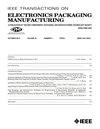Development of Warpage Measurement System to Simulate Convective Solder Reflow Process
IEEE Transactions on Electronics Packaging Manufacturing
Pub Date : 2008-01-07
DOI:10.1109/TEPM.2007.914220
引用次数: 5
Abstract
In this paper, a warpage measurement system to simulate forced convective reflow is discussed. A warpage measurement system that can simulate convective reflow enables the real-time monitoring of printed wiring boards (PWBs), PWB assemblies (PWBAs), and chip package warpage during the reflow process. This paper will describe the two major parts of the warpage measurement system: the optical measurement part which utilizes the projection Moire method and advanced image processing, as well as the laboratory oven which is used to simulate forced convective reflow. This is the first system that allows PWB/PWBA/chip package warpage to be measured during a simulated convective reflow process. Also, this is the first system that employs automatic image segmentation to separately extract the warpage of the PWB and electronic components from the same measurement. The results will show that when compared to infrared heating which was previously used in this research area, convective heating minimizes thermal gradients on the PWB/PWBA sample. Thermal gradients on the PWB/PWBA sample have the inadvertent effect of inducing warpage into the sample and will interfere with the warpage measurement result. In the first design iteration presented in this paper, the system can simulate low ramp rate industrial convective reflow profiles and simultaneously measure the warpage of PWBAs. A computational fluid dynamics (CFD) model of the system was developed to determine how to increase the system's heating rate. The CFD model was used to perform a design of simulations (DOS) and regression analysis. The validated regression results will be used to predict oven design parameters to enable the next iteration of the convective system to simulate high ramp rate convective reflow profiles. This paper will show that the presented system is a powerful tool for measuring the warpage of PWBs, PWBAs, and chip packages.模拟焊料对流回流过程的翘曲测量系统的研制
本文讨论了一种模拟强制对流回流的翘曲测量系统。可以模拟对流回流的翘曲测量系统可以实时监测回流过程中的印刷线路板(PWB), PWB组件(pwba)和芯片封装翘曲。本文将介绍翘曲测量系统的两个主要部分:利用投影云纹法和先进的图像处理技术的光学测量部分,以及用于模拟强制对流回流的实验室烘箱。这是第一个允许在模拟对流回流过程中测量PWB/PWBA/芯片封装翘曲的系统。此外,这是第一个采用自动图像分割的系统,可以从同一测量中分别提取PWB和电子元件的翘曲。结果将表明,与之前在该研究领域使用的红外加热相比,对流加热使PWB/PWBA样品上的热梯度最小化。PWB/PWBA样品上的热梯度会无意中引起样品翘曲,并会干扰翘曲测量结果。在本文提出的第一次设计迭代中,该系统可以模拟低斜坡率工业对流回流曲线,同时测量pwba的翘曲。建立了系统的计算流体动力学(CFD)模型,以确定如何提高系统的加热速率。采用CFD模型进行了模拟设计(DOS)和回归分析。经过验证的回归结果将用于预测烘箱的设计参数,以使对流系统的下一次迭代能够模拟高斜坡速率的对流回流剖面。本文将展示该系统是测量pwb、pwba和芯片封装翘曲的强大工具。
本文章由计算机程序翻译,如有差异,请以英文原文为准。
求助全文
约1分钟内获得全文
求助全文

 求助内容:
求助内容: 应助结果提醒方式:
应助结果提醒方式:


